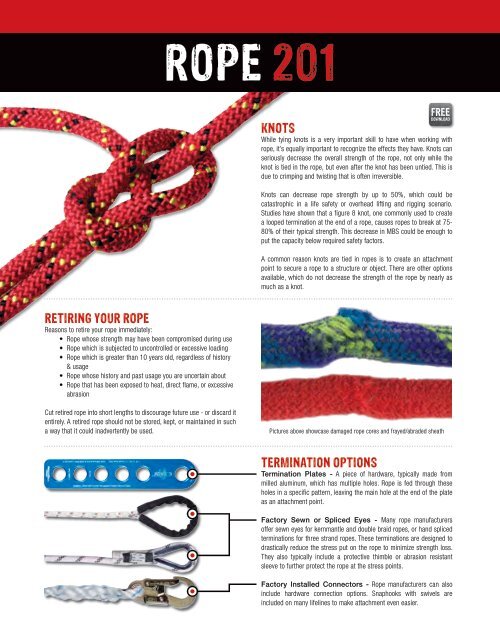GME Supply Catalog Version 19.1
GME Supply is North America's premier outfitter of fall protection, safety equipment, and gear for at-height workers, industry, and construction.
GME Supply is North America's premier outfitter of fall protection, safety equipment, and gear for at-height workers, industry, and construction.
Create successful ePaper yourself
Turn your PDF publications into a flip-book with our unique Google optimized e-Paper software.
CSA Z259N12<br />
ANSI Z359 12<br />
Gate 3600 LB<br />
ROPE 201<br />
KNOTS<br />
While tying knots is a very important skill to have when working with<br />
rope, it’s equally important to recognize the effects they have. Knots can<br />
seriously decrease the overall strength of the rope, not only while the<br />
knot is tied in the rope, but even after the knot has been untied. This is<br />
due to crimping and twisting that is often irreversible.<br />
Knots can decrease rope strength by up to 50%, which could be<br />
catastrophic in a life safety or overhead lifting and rigging scenario.<br />
Studies have shown that a figure 8 knot, one commonly used to create<br />
a looped termination at the end of a rope, causes ropes to break at 75-<br />
80% of their typical strength. This decrease in MBS could be enough to<br />
put the capacity below required safety factors.<br />
A common reason knots are tied in ropes is to create an attachment<br />
point to secure a rope to a structure or object. There are other options<br />
available, which do not decrease the strength of the rope by nearly as<br />
much as a knot.<br />
HARDWARE // NON-ANSI RATED CONNECTORS<br />
RETIRING YOUR ROPE<br />
Reasons to retire your rope immediately:<br />
• Rope whose strength may have been compromised during use<br />
• Rope which is subjected to uncontrolled or excessive loading<br />
• Rope which is greater than 10 years old, regardless of history<br />
& usage<br />
• Rope whose history and past usage you are uncertain about<br />
• Rope that has been exposed to heat, direct flame, or excessive<br />
abrasion<br />
Cut retired rope into short lengths to discourage future use - or discard it<br />
entirely. A retired rope should not be stored, kept, or maintained in such<br />
a way that it could inadvertently be used.<br />
Pictures above showcase damaged rope cores and frayed/abraded sheath<br />
TERMINATION OPTIONS<br />
Termination Plates - A piece of hardware, typically made from<br />
milled aluminum, which has multiple holes. Rope is fed through these<br />
holes in a specific pattern, leaving the main hole at the end of the plate<br />
as an attachment point.<br />
Factory Sewn or Spliced Eyes - Many rope manufacturers<br />
offer sewn eyes for kernmantle and double braid ropes, or hand spliced<br />
terminations for three strand ropes. These terminations are designed to<br />
drastically reduce the stress put on the rope to minimize strength loss.<br />
They also typically include a protective thimble or abrasion resistant<br />
sleeve to further protect the rope at the stress points.<br />
Factory Installed Connectors - Rope manufacturers can also<br />
include hardware connection options. Snaphooks with swivels are<br />
included on many lifelines to make attachment even easier.<br />
(800) 940-6762<br />
63<br />
23kN 13 YVN

















